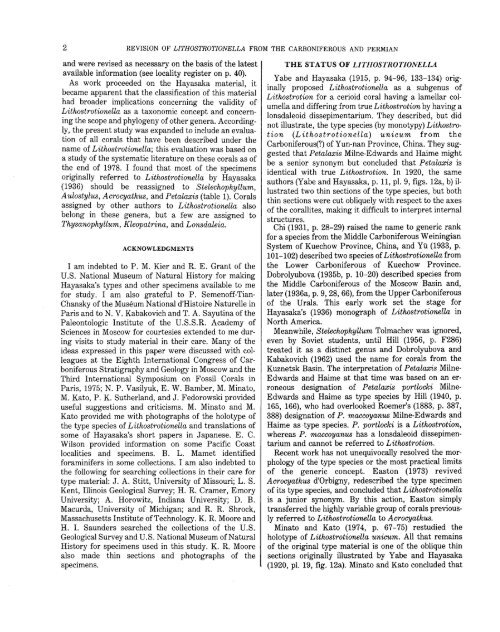Revision of Lithostrotionella - USGS
Revision of Lithostrotionella - USGS
Revision of Lithostrotionella - USGS
You also want an ePaper? Increase the reach of your titles
YUMPU automatically turns print PDFs into web optimized ePapers that Google loves.
2 REVISION OF LITHOSTROTIONELLA FROM THE CARBONIFEROUS AND PERMIAN<br />
and were revised as necessary on the basis <strong>of</strong> the latest<br />
available information (see locality register on p. 40).<br />
As work proceeded on the Hayasaka material, it<br />
became apparent that the classification <strong>of</strong> this material<br />
had broader implications concerning the validity <strong>of</strong><br />
<strong>Lithostrotionella</strong> as a taxonomic concept and concerning<br />
the scope and phylogeny <strong>of</strong> other genera. Accordingly,<br />
the present study was expanded to include an evaluation<br />
<strong>of</strong> all corals that have been described under the<br />
name <strong>of</strong> <strong>Lithostrotionella</strong>; this evaluation was based on<br />
a study <strong>of</strong> the systematic literature on these corals as <strong>of</strong><br />
the end <strong>of</strong> 1978. I found that most <strong>of</strong> the specimens<br />
originally referred to <strong>Lithostrotionella</strong> by Hayasaka<br />
(1936) should be reassigned to Stelechophyllum,<br />
A ulostylus, Acrocyathus, and Petalaxis (table 1). Corals<br />
assigned by other authors to <strong>Lithostrotionella</strong> also<br />
belong in these genera, but a few are assigned to<br />
Thysanophyllum, Kleopatrina, and Lonsdaleia.<br />
ACKNOWLEDGMENTS<br />
I am indebted to P. M. Kier and R. E. Grant <strong>of</strong> the<br />
U.S. National Museum <strong>of</strong> Natural History for making<br />
Hayasaka's types and other specimens available to me<br />
for study. I am also grateful to P. Semen<strong>of</strong>f-Tian<br />
Chansky <strong>of</strong> the Museum National d'Histoire Naturelle in<br />
Paris and to N. V. Kabakovich and T. A. Sayutina <strong>of</strong> the<br />
Paleontologic Institute <strong>of</strong> the U.S.S.R. Academy <strong>of</strong><br />
Sciences in Moscow for courtesies extended to me during<br />
visits to study material in their care. Many <strong>of</strong> the<br />
ideas expressed in this paper were discussed with colleagues<br />
at the Eighth International Congress <strong>of</strong> Carboniferous<br />
Stratigraphy and Geology in Moscow and the<br />
Third International Symposium on Fossil Corals in<br />
Paris, 1975; N. P. Vasilyuk, E. W. Bamber, M. Minato,<br />
M. Kato, P. K. Sutherland, and J. Fedorowski provided<br />
useful suggestions and criticisms. M. Minato and M.<br />
Kato provided me with photographs <strong>of</strong> the holotype <strong>of</strong><br />
the type species <strong>of</strong> <strong>Lithostrotionella</strong> and translations <strong>of</strong><br />
some <strong>of</strong> Hayasaka's short papers in Japanese. E. C.<br />
Wilson provided information on some Pacific Coast<br />
localities and specimens. B. L. Mamet identified<br />
foraminifers in some collections. I am also indebted to<br />
the following for searching collections in their care for<br />
type material: J. A. Stitt, University <strong>of</strong> Missouri; L. S.<br />
Kent, Illinois Geological Survey; H. R. Cramer, Emory<br />
University; A. Horowitz, Indiana University; D. B.<br />
Macurda, University <strong>of</strong> Michigan; and R. R. Shrock,<br />
Massachusetts Institute <strong>of</strong> Technology. K. R. Moore and<br />
H. I. Saunders searched the collections <strong>of</strong> the U.S.<br />
Geological Survey and U.S. National Museum <strong>of</strong> Natural<br />
History for specimens used in this study. K. R. Moore<br />
also made thin sections and photographs <strong>of</strong> the<br />
specimens.<br />
THE STATUS OF LITI/OSTROTIONELLA<br />
Yabe and Hayasaka (1915, p. 94-96, 133-184) originally<br />
proposed <strong>Lithostrotionella</strong> as a subgenus <strong>of</strong><br />
Lithostrotion for a cerioid coral having a lamellar columella<br />
and differing from true Lithostrotion by having a<br />
lonsdaleoid dissepimentarium. They described, but did<br />
not illustrate, the type species (by monotypy) L·ithostrotion<br />
(<strong>Lithostrotionella</strong>) unicum from the<br />
Carboniferous(?) <strong>of</strong> Yun-nan Province, China. They suggested<br />
that Petalaxis Milne-Edwards and Hairne might<br />
be a senior synonym but concluded that Petnlaxis is<br />
identical with true Lithostrotion. In 1920, the same<br />
authors (Yabe and Hayasaka, p. 11, pl. 9, figs. 12a, b) illustrated<br />
two thin sections <strong>of</strong> the type species, but both<br />
thin sections were cut obliquely with respect to the axes<br />
<strong>of</strong> the corallites, making it difficult to interpret internal<br />
structures.<br />
Chi (1931, p. 28-29) raised the name to generic rank<br />
for a species from the Middle Carboniferous W einingian<br />
System <strong>of</strong> Kuechow Province, China, and Yu (1933, p.<br />
101-102) described two species <strong>of</strong> <strong>Lithostrotionella</strong> from<br />
the Lower Carboniferous <strong>of</strong> Kuechow Province.<br />
Dobrolyubova (1935b, p. 10-20) described species from<br />
the Middle Carboniferous <strong>of</strong> the Moscow Basin and,<br />
later (1936a, p. 9, 28, 66), from the Upper Carboniferous<br />
<strong>of</strong> the Urals. This early work set the stage for<br />
Hayasaka's (1936) monograph <strong>of</strong> <strong>Lithostrotionella</strong> in<br />
North America.<br />
Meanwhile, Stelechophyllum Tolmachev was :ignored,<br />
even by Soviet students, until Hill (1956, p. F286)<br />
treated it as a distinct genus and· Dobrolyubova and<br />
Kabakovich (1962) used the name for corals from the<br />
Kuznetsk Basin. The interpretation <strong>of</strong> Petalaxis Milne<br />
Edwards and Haime at that time was based on an erroneous<br />
designation <strong>of</strong> Petalaxis portlocki Milne<br />
Edwards and Haime as type species by Hill (1940, p.<br />
165, 166), who had overlooked Roemer's (1883:, p. 387,<br />
388) designation <strong>of</strong> P. maccoyanus Milne-Edwards ~nd<br />
· Haime as type species. P. portlocki is a Lithostrotion,<br />
whereas P. maccoyanus has a lonsdaleoid dissepimentarium<br />
and cannot be referred to Lithostrotion.<br />
Recent work has not unequivocally resolved the morphology<br />
<strong>of</strong> the type species or the most practical limits<br />
<strong>of</strong> the generic concept. Easton (1973) revived<br />
Acrocyathus d'Orbigny, redescribed the type specimen<br />
<strong>of</strong> its type species, and concluded that <strong>Lithostrotionella</strong><br />
is a junior synonym. By this action, Easton simply<br />
transferred the highly variable group <strong>of</strong> corals previously<br />
referred to <strong>Lithostrotionella</strong> to Acrocyathus.<br />
Minato and Kato (1974, p. 67-75) restudied the<br />
holotype <strong>of</strong> <strong>Lithostrotionella</strong> unicum. All that remains<br />
<strong>of</strong> the original type material is one <strong>of</strong> the oblique thin<br />
sections originally illustrated by Yabe and Hayasaka<br />
(1920, pl. 19, fig. 12a). Minato and Kato concluded that

















